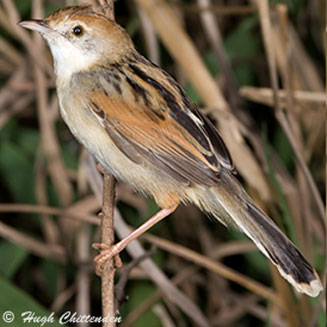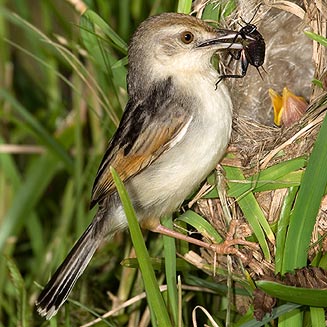|
Cisticola galactotes (Rufous-winged
cisticola, Black-backed cisticola)
Swartrugtinktinkie [Afrikaans]; Harudeve (generic term for
cisticola or prinia) [Kwangali]; Zwartrug-graszanger [Dutch]; Cisticole
roussâtre [French]; Schwarzrücken-zistensänger [German];
Fuinha-de-dorso-preto [Portuguese]
Life
> Eukaryotes >
Opisthokonta
> Metazoa (animals) >
Bilateria >
Deuterostomia > Chordata >
Craniata > Vertebrata (vertebrates) > Gnathostomata (jawed
vertebrates) > Teleostomi (teleost fish) > Osteichthyes (bony fish) > Class:
Sarcopterygii (lobe-finned
fish) > Stegocephalia (terrestrial
vertebrates) > Tetrapoda
(four-legged vertebrates) > Reptiliomorpha > Amniota >
Reptilia (reptiles) >
Romeriida > Diapsida > Archosauromorpha > Archosauria >
Dinosauria
(dinosaurs) > Saurischia > Theropoda (bipedal predatory dinosaurs) >
Coelurosauria > Maniraptora > Aves
(birds) >
Order: Passeriformes > Family: Cisticolidae
> Genus: Cisticola
For information on how to distinguish this species from the
Luapula
cisticola, see
birdinfo.co.za.
 |
|
|
Rufous-winged cisticola, KwaZulu-Natal, South
Africa. [photo Hugh Chittenden ©] |
|
Distribution and habitat
Near-endemic to southern Africa, occurring from southern
Malawi to southern Mozambique and Kwazulu-Natal. Here it prefers reedbeds and
other vegetation along rivers and lakes, water bodies within cultivated land and
even very disturbed areas like weedy growth along canals.
Food
It mainly eats invertebrates, doing most of its foraging in
the undergrowth or along patches of floating Kariba weed (Salvinia molesta). The following food items have been recorded
in its diet:
Breeding
- The nest (see image below) is an oval or ball shape with a side entrance,
built of dry grass but also living grass blades are woven into the outer
shell. The interior is lined by the female during incubation with
plant down and grass inflorescences, while the exterior may be decorated
with bark, cocoons and pieces of plant. It is typically placed in a marsh
near the water surface, amongst grass or reeds up to about 1.2 metres above
ground.
- Egg-laying season is from September-February.
 |
|
|
Rufous-winged cisticola, KwaZulu-Natal, South
Africa. [photo Hugh Chittenden ©] |
|
- It lays 2-4 eggs, which are probably incubated for about 12-13 days.
- The chicks are fed by both parents, leaving the nest after about 14-17
days.
Threats
Not threatened.
References
-
Hockey PAR, Dean WRJ and Ryan PG 2005. Roberts
- Birds of southern Africa, VIIth ed. The Trustees of the John Voelcker
Bird Book Fund, Cape Town.
|
